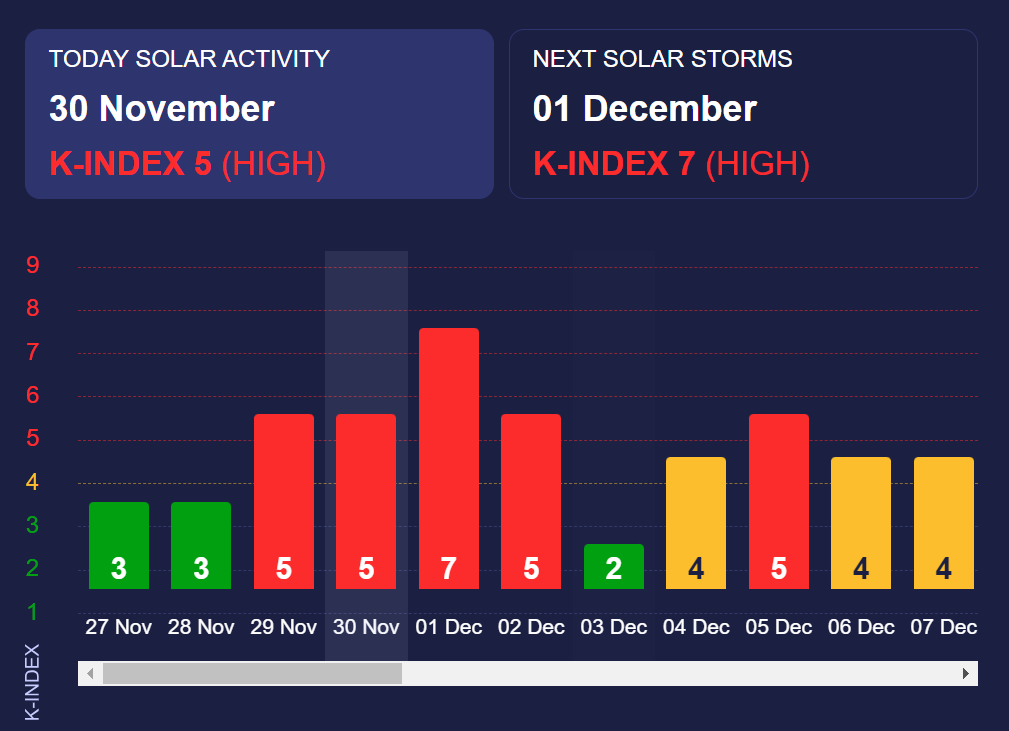Unforeseen magnetic storm threatens Earth: Experts warn of health impacts
 High-level magnetic storm engulfs Earth (Collage by RBC-Ukraine)
High-level magnetic storm engulfs Earth (Collage by RBC-Ukraine)
A strong magnetic storm will hit the Earth on Friday, December 1. It is expected that this magnetic storm will reach a red level, K-index of 7. Such a storm can cause disruptions in electronics and severe headaches.
What is known about this storm and how to protect your body is explained, based on Meteoagent.
What are magnetic storms?
Powerful flashes and eruptions on the Sun, occurring regularly, lead to the release of solar energy into space. These emissions disperse in various directions, including towards Earth.
Solar energy in these eruptions consists of charged particles - protons and electrons that can move rapidly in space. When streams of this energy reach the Earth's magnetosphere, they provoke activity known as a magnetic or solar storm.
Scientists classify all storms based on their strength, ranging from K-index 2 to K-index 9. The higher the K-index, the stronger the storm and its consequences. All storms above K-index 5 are considered red level storms, which can potentially impact human life.
Such storms can cause disruptions in satellite operations, mobile or radio communication, and GPRS. Additionally, during these storms, people may experience worsened well-being. During storms exceeding K-index 7, Northern (polar) lights might be observed.
What's known about the upcoming storm?
According to data from NOAA, TESIS satellite systems, and international meteorological laboratories worldwide, a red level K-index 5 storm began yesterday, November 29. By December 1, it will reach a K-index 7, corresponding to a strong red-level magnetic storm. On December 2, a K-index storm is expected before the magnetosphere briefly returns to normal.
Experts predict a K-index 4 on December 4, which will again reach the red-level K-index 5 on December 5.

Photo: Magnetic storm on December 1
How do magnetic storms affect humans?
Scientists worldwide have been debating the impact of magnetic storms on humans for many years, and there is a series of studies confirming the correlation between people's deteriorating well-being on such days and increased geomagnetic activity.
People usually complain of the following symptoms during these times:
- Headaches
- Dizziness
- Migraines
- Mental fog
- Reduced concentration and focus
- Daytime sleepiness
- Sleep problems at night
- General weakness
- Rapid fatigue
- Increased anxiety
- Irritability
- Exacerbation of chronic illnesses
Most often, people seek medical help on such days, especially from cardiologists.
But the most significant danger of magnetic storms is for astronauts who are outside the protective shield of Earth's atmosphere. They may be exposed to high levels of radiation, significantly increasing the risk of developing cancer.
How to help your body during magnetic storms
Doctors provide general recommendations for these days, urging people to rest more, get enough sleep, maintain a regular daily routine, and eat well. Additionally:
- Reduce physical and emotional stress
- Maintain hydration
- Drink herbal teas and infusions
- Take walks in the fresh air
- Limit alcohol and cigarettes
- Take a contrast shower in the morning and exercise
- Ventilate rooms
- Choose quieter types of sports
- Engage in calm activities in the evenings
- If necessary, seek help from specialists

